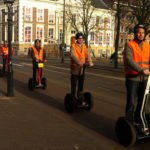From kick scooters to electric bikes – the changes in city travel
Mobility is one of the hot topics for any major city. Up until now, mobility policies were based on a combination of, primarily, motor and overground public and private transportation. But this model is showing signs of wear in many cities. The main alternative has been subways and unground transportation systems. However, lately new trends in urban travel have emerged; they involve traditional means of transport now equipped with an engine, such as kick scooters and electric bikes. They reflect a change in how people move around in cities.

Big Data must be taken into account as a tool for local authorities to find out how people are actually travelling, and to plan their resources to adapt to these choices. Some of the current initiatives include planning of public transportation, parking spaces for residents and pedestrian-only areas during certain time periods.
Mobility issues in big cities
Contamination and air quality are two of the main issues faced by big cities. For this reason, cities such as Paris have occasionally restricted vehicle access; and cities such as London have applied access fees for some time now. For these reasons, there are very few people who can travel to work in their own vehicles.
And we should not forget increased fuel prices, which seem to have stabilized for now but have doubled over the last 10 years. To some extent, all these factors combined explain why alternative transportation systems have reached a peak, and now show very quick amortization.
To this, we should add several policies that aim at reintroducing bikes into a slightly calmer traffic environment, where there are less vehicles. For instance, France has been encouraging people to cycle to work: employees who choose the bike as a means of transport are paid 25 cents per kilometer. There are also public bike systems, where users from outside the city can cycle the last few kilometers between bike stations and their place of work. Cycling to work is already a preferred choice of commuters, who favor folding bikes as they can take them on public transport and keep them in their offices.

The phenomenon of urban gentrification
This issue can also be assessed in light of the gentrification phenomenon experienced in many cities. City centers are regaining their value as residential areas. In some cases, there is even massification: in San Francisco, for instance, this has raised concerns as many startup to the center due to its proximity to Silicon Valley. However, in all other cities, gentrification has meant that their centers have been renewed for residential purposes, setting aside the service sector (mostly leisure facilities and offices).
In addition to public transportation, people living in the center are starting to use alternative means of transport, which make door-to-door travel easier. People value the time they save by going from home to work rather than from station to station.
And this is where alternative means of transport come in. Is it quicker to use a public bike for a short trip instead of taking the subway or waiting for the bus? Is using a kick scooter or bike feasible?
Electric motors, a growing trend
At the same time as this happens, or maybe because of this, we are seeing a small boom of electric motors, either as the main vehicle driver or as part of hybrid solutions. This technology helps to reduce energy use, and promises to be the way of the future once some questions about charging and battery life are solved.
Meanwhile, these R+D+i developments can be applied to lighter means of transport. Electric bikes are also benefiting from the Spanish government PIVE plan to replace vehicles with less polluting options, in different models and with different features. Electric bikes are suitable for (on average) 15-km daily trips with the added benefit of not having to always pedal.
Examples of this include GoCycle, an electric folding bike that fits into a case. There is also Gi Bike, a similar initiative that also focused on the link between bike and smartphone. Or the more extravagant Concept, which tries to reinvent early 20th century bikes.
But there are other initiatives, such as the bike designed by Stark, smart wheelssuch as the Copenhagen Wheel or Flikky, which allow you to turn any bike into an electric model with its pedal-assist feature controlled and connected to your smartphone. The bike created by VanMoof goes even further, and offers us a very urban solution with everything you need to travel in the city.
But electric motors are not restricted to bikes. Even though some Segways can be found in the cities, this interesting vehicle has not been able to carve its urban niche. This may be due to the fact that it is too fast for the sidewalk and too slow for the road. And we should not forget its size, weight and price. An electric mini-farthing, YikeBike, is an interesting alternative, and it folds. It uses our center of gravity and balance and has a similar price to Segways but it is easier to carry, and cycling around traffic is simpler.
A more common choice are much more traditional-looking kick scooters such as the L-Trotter: their electric motor and weight make for quick city travel. Another example is the recently-unveiled Mini prototype. Although it may be slightly heavier than other alternatives, its innovative aesthetics is combined with smartphones as a navigator.
On a more leisurely note, we could mention the OneWheel, the single-wheel electric skateboard or BajaBoard, the all-terrain skateboard. Crowdfunding is often used for this type of alternative vehicles, whether their aim is leisure or city travel.